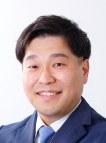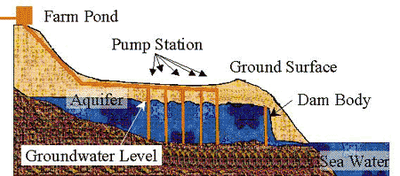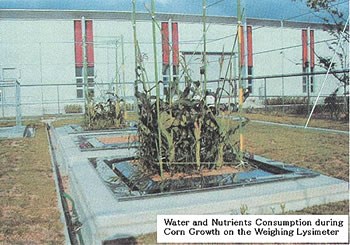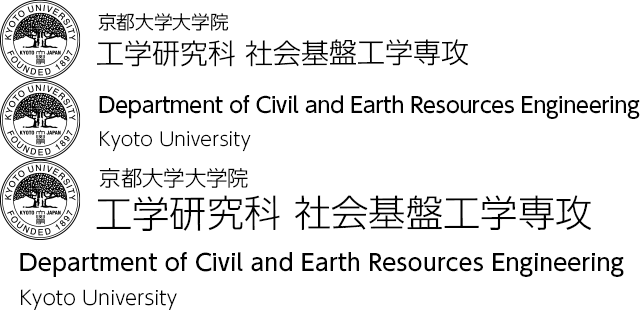Hydrometeorological Disasters Engineering
Our research objectives are prevention and mitigation of flood damage in urban area and wise use and conservation of water resources. Observation and analysis of water, pollution and heat balance in the urban area is carried out by using hydrology, groundwater, geostatistics and environmental engineering. It can show, especially, the change of stormwater and pollutant runoff mechanisms affected by urbanization. And we are struggling to develop the simulation model for design and management of underground dam, and analyse the groundwater pollution.
Academic Staff
Kosei YAMAGUCHI
Professor (Disaster Prevention Research Institute)
Research Topics
I am working on developing hydrometeorological strategies for heavy rainfall disaster prevention from numerical models and observations. My goal is to establish a conviviality between heavy rainfall, human society, and monitoring, forecasting, and control technologies to protect the smiles of future generations.
Contacts
E-529D, Disaster Prevention Research Institute, Uji Campus
TEL: +81-774-38-4262
FAX: +81-774-38-4265
E-mail: yamaguchi.kosei.5r![]() kyoto-u.ac.jp
kyoto-u.ac.jp
Yukari (OSAKADA) NAKA
Assistant Professor (Disaster Prevention Research Institute)
 Research Topics
Research Topics
My research is on the mechanisms of extreme rainfall and its future changes due to global warming based on climate/ meteorological modelling and observation. The linkage of meteorology, climatology, and engineering is an important key of my research to achieve the disaster prevention and mitigation.
Contacts
E-531D, Disaster Prevention Research Institute, Uji Campus
TEL: +81-774-38-4266
FAX: +81-774-38-4266
E-mail: osakada![]() hmd.dpri.kyoto-u.ac.jp
hmd.dpri.kyoto-u.ac.jp
Research Topics
Observation of hydrology and environmental situation and analysis of water and pollution cycle in Kyoto basin
Observation of hydrology and environmental situation and analysis of water and pollution balance in Kyoto basin. Increasing of storm runoff and pollutant runoff by urbanization causes flood disaster and environmental pollution in urban area.
Hydrological and environmental observations have been carried on in several rural and urban watersheds. On the basis of the observed data, the effects of watershed urbanization have been examined on several hydrological aspects such as the rainfall infiltration , the hydrological roughness of slope surface, and the concentration time of flood runoff. In addition, in order to mitigate flood disasters and environmental pollution due to urbanization of watersheds, technologies for stormwater storage and infiltration is discussed experimentally and theoretically.
And integrated analysis of surface and underground water behavior is struggled as new research target in urban basin. This research is fundamental study for analysis of water and pollutant material budget affected by the global warming in near future. Interrelation between natural and artificial water behavior is solved by the integrated simulation model. Technologies for water resources management and water environment conservation in urban area should be discussed for the sustainable water environment by physical and societal theory.

Figure 1: Pollutant reduction by the small size of roof runoff storage
Utilization and conservation of underground water
Underground dam is a kind of method to develop water resource, and is effective especially in islands, peninsulas and arid climates. Field studies have been carried out to clarify distributions and changes in groundwater level, as well as the status of salinity intrusion into an aquifer. Furthermore, numerical model of saturated-unsaturated seepage is developed and applied to an actual underground dam. Three dimensional characteristics of groundwater flow over the dam body is simulated and examined. And estimation method of spatio-temporal of underground water calculated from limited number of observation data is developed and improved by using geostatistics theory.

Figure 2: Sketch of underground dam

Figure 3: Three dimensional numerical simulation of groundwater flow in Sunagawa underground dam site
Observation of water and nutrients consumption during plant growth
In order to elemental hydrological process during plant growth, water and nutrients balance is observed by the weighing Lysimeter. Results of observation indicated that the evapotranspiration in planted soil-tank is 2.1 to 2.2 times that in a barren soil-tank. Surface runoff in a barren soil-tank is 2.9 to 3.0 times that in planted soil tank. 3 tons of water, 130 g of nitrogen and 30 g of phosphorus are consumed for 1kg harvest of corn caryopses.

Figure 4: Observation of water and nutrients balance by weighing Lysimeter
